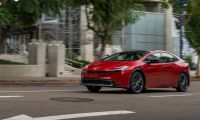Despite the constant media coverage of cell-phone and texting related accidents, the data do not lie – As cell phones became popular in the United States traffic deaths declined. We are all entitled to our own opinions about cell phone use in cars, but we are not entitled to our own facts. Torque news looked at a variety of sources. Mainly National Highway Traffic Safety Administration (NHTSA), Insurance Institute for Highway Safety (IIHS) and Highway Loss Data Institute (HLDI) reports, going as far back as 1985, to see what the data say about accidents, accident deaths and cell phone usage. What the data show is that as cell phones were introduced, and then became popular, and then almost universally used, the chances of being killed in an automobile accident declined – and declined dramatically. This is not a single anomalous report either. Age groups that use cell phones the most declined the most. Those that did not use cell phones much (those over 70 years of age) actually increased recently in certain years.
When Did Cell Phones Become Part Of Driving
When did cell phones start to become truly universal? In the late 1980s mobile phones were everywhere. The first Blackberry, which perfected e-mail via cell phones, was released in 1999. The first iPhone was released in 2007. This timeline helps us understand the progression of hand-held devices in America as we look at the traffic death and accident data.
Accidents Per Mile Driven Are the Key
In order to compare accident deaths it is important to look at accidents per miles driven as well as overall deaths. That eliminates changes to the driving population. In 1988, our starting point, there were 47,087 traffic deaths*. At that time the rate of people killed per 100 million miles travelled was 2.32. As cell phones became popular the rate of deaths and the overall deaths both begin to decline. By the year 2000, the year after the Blackberry is introduced, the number of overall deaths has declined to 41,945 and the rate of deaths per 100 million miles driven is now down to 1.53. In 2008, the year after the iPhone is introduced, these numbers decline to 37,423 and a rate of 1.26. Thus, the simple -and data driven- conclusion is that from the time just before cell phones become universal, until they are completely commonplace, the chance of being killed in a car crash is cut in half (A decline from 2.32 to 1.26 is actually a 46% decrease). By 2010, the last year the report has complete data, the accident rate per 100 miles driven has declined further to 1.11, which is more than a 50% decrease in one’s chances of being killed in a motor vehicle related accident.
Motor Vehicle Deaths Decline As Cell Phones Become Popular
Those who don’t prefer facts, but rather base their thoughts and concerns on anecdotes and individual observances, will at this point begin to look for mistakes in the data, or some trick. There is none. In fact, this quotation by the IIHS in their most recent overall report on declining accident deaths is very telling “From 1975 to 2010, the rate of deaths per 100,000 people declined by… 65 percent for teenagers (from 29.4 to 10.3 per 100,000), 48 percent for people ages 20-34 (from 29.6 to 15.4 per 100,000), 37 percent for people ages 35-69 (from 17.5 to 11.1), and 43 percent for people 70 and older (from 25.9 to 14.9 per 100,000). The 70 and older age group was the only age group for which the death rate increased from 2009 to 2010.” Looking in to the data we find a very interesting fact. In 1988 the death rate of those ages 20 to 35 years of age (caused by a vehicle) is 28.1. By 2000 it has dropped to 20.6, and by 2010 the rate is 15.4. This means that the group most likely to be using cell phones and texting is dropping year after year as cell phones become more popular. The age group under this also declines just as dramatically, but it includes those under 16 (non-drivers), so we have not included the numbers for fear of being accused of providing misleading examples. There is only one group by age that did NOT see a decrease in traffic deaths from 2009 to 2010, but rather saw an increase. That is the 70+ age group. Ask yourself honestly if you think that group is doing a lot of texting while they drive.
What Does Cause Traffic Deaths
So what are the causes of accidents if cell phones are not the problem? According to the facts, and quoted here from the IIHS report “Speeding has been a factor in about one-third of crash deaths since 2001.” Speeding is a cause, and it is not declining as a cause over the past 10 years (from 2001 to 2010). We also know that in 2010 alcohol was responsible for 31% of all fatal crashes** So we know that speed and alcohol are blamed for about two-thirds of all fatal crashes. This is not in dispute. Also, we know that of the approximately 30,000 total fatalities caused by motor vehicles of all types in 2010, 4,502 of those were motorcycle deaths. Were some caused by texters hitting motorcyclists? Perhaps, but we do know that since 1988 the percentage of deaths by motorcyclists actually doubled! The total number of motorcyclists killed in 1986 (before cell phones were popular) was 4,309. That exact same number was killed in 2010, despite a huge percentage drop in motor vehicle deaths overall.* Therefore, it is pretty hard to blame texters and folks on cell phones for the deaths of motorcyclists.
Here is a quick breakdown of who dies in vehicle crashes; about a third from speed, about a third from alcohol, about 14% are over the age of 70, about 13% are death by motorcycle. That leaves about 9% of all vehicle related deaths to be caused by all other factors. Those include weather, mechanical failure, pedestrians who are killed accidentally while walking at night, large truck crashes due to fatigue, drivers who fall asleep, drugged drivers, bus crashes, distracted drivers not using a cell phone… You get the picture.
The next time you hear a report saying that your chances of being killed in an accident while texting are greater, challenge the data.
*Institute For Highway Safety Report “Fatality Facts 2010” released March 23, 2012. Note that the actual data are supplied by the United States Department of Transportation in the Fatality Analysis Reporting System.
**National Highway Safety Administration Fatality Analysis Reporting System.













Comments
Unless IIHS is separating
Permalink
Unless IIHS is separating speeding deaths from alcohol deaths, you can't add those percentages and conclude that speeding and alcohol are the cause in two-thirds of fatal accidents. A lot of drunk drivers speed.
In addition, are the IIHS numbers about those who are under the influence of alcohol exclusive of those under the influence of other drugs?
Consider, also, unquantifiable factors: cars are much safer than they were in 1989 and motorcycles are much faster.
I'm not saying that all that changes the argument significantly. Texting drivers are a hazard, but to what extent still lacks a great deal of data. We've all been annoyed by someone on a mobile who's not paying attention, but that's not evidence of fatal risk. The same can be said of women putting on makeup or men fiddling with the radio.
Excellent points: - IIHS
Permalink
In reply to Unless IIHS is separating by Bob (not verified)
Excellent points:
- IIHS (NHTSA actually) does specifically segregate the police reports PRIMARY contributing cause of the accident. Therefore, if the driver was drunk that is an alcohol related death, even if the driver was doing 36 in a 35 zone. If the driver was not drunk, but speeding dramatically that is a speeding death. As the joke goes, speed is not a problem it is sudden decelleration that causes the problems. Motorcylces are not faster now than in 1989. A Ninja then was capapble of killing a person just as well as a new Ninja. Actually, with anti-lock brakes and modern tires it is easy to argue motorcyles are much safer now. The truth behind those statistics is the reason for the increase is that baby boomers are now pretend outlaw bikers. And they die. Thanks for reading and challenging the data and content.
I'd argue that the 700cc and
Permalink
In reply to Excellent points: - IIHS by John Goreham
I'd argue that the 700cc and above bikes are faster, not radically, but the top speeds are way beyond what was out in '89. Huyabusa didn't arrive until '99. But, antilock, tires, suspensions are better. I wonder how many of these new rich urban bikers have taken the MSF course? I took the basic twice and the advanced once. Saved my life at least once.
Overall, there doesn't appear to be the kind of even small news correlation to mobile devices and deaths. States often lag behind on adding causation factors, so there might one day be real data, but I suspect it will all fall under an umbrella term like "distracted."